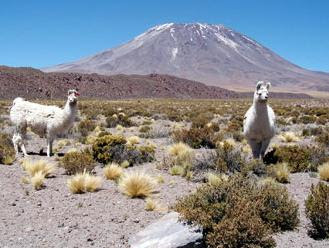Mount Pelee is the result of a subduction zone which formed the Lesser Antilles island arc, a curved chain of volcanoes approximately 850 kilometers in length, between Puerto Rico and Venezuela, where the Caribbean Plate meets Atlantic Oceanic crust belonging to the South American Plate. Other volcanoes in the island arc are also active, including Saint Vincent's La Soufrière, Guadeloupe's Soufriere volcano, Montserrat's Soufrière Hills, and the submarine volcano Kick-'em-Jenny.
Geological History of Mount Pelee
In the geological evolution of Mount Pelee volcano, three different phases have been identified: initial, intermediate, and modern. In an initial phase, called the Paleo-Pelee stage, Mount Pelee was a common stratovolcano. The cone of Paleo-Pelee was composed of many layers of lava flows and fragmented volcanic debris. Remains of the Paleo-Pelee cone are still visible at the northern view at the volcano today.
A second stage, now called the intermediate phase, started around 100,000 years ago, after a long period of quiescence. This stage is grouped by the formation of the Morne Macouba lava dome, then later on, the Morne Macouba caldera. During the intermediate phase, there were several eruptions which produced pyroclastic flows like those that destroyed Saint-Pierre in the 1902 eruption. Around 25,000 years ago, a large Southwest sector collapse occurred, forming a landslide. This event is similar to the eruption of Mount Saint Helens in 1980.
The modern stage of the evolution of Mount Pelée has created most of the current cone, with deposits of pumice and the results of past pyroclastic flows. More than 30 eruptions have been identified during the last 5,000 years of the volcano's activity.
Eruption of Mount Pelee
The Mount Pelee is famous for its eruption in 1902 and the destruction that resulted, now dubbed the worst volcanic disaster of the 20th century. The eruption killed about 30,121 people. Most deaths came from the city of Saint-Pierre, at that time the largest city in Martinique, due to its pyroclastic flows. Before the tragic 1902 eruption, as early as the summer of 1900, signs of increased fumarole activity had been present in the Étang Sec crater near the summit.
Relatively minor phreatic eruptions which had occurred in 1792 and 1851 were evidence that the volcano was active and potentially dangerous. Local natives, the Carib people, knew it as "fire mountain" from previous eruptions in ancient times.
Mount Pelee began its eruptions on April 23, 1902. In early April, excursionists noted the appearance of sulfurous vapors emitting from fumaroles near the mountaintop. This was not regarded as important, as fumaroles had been appearing and disappearing in the past. Nevertheless, on April 23, the mountain caused a light rain of cinders on its southern and western side, together with sharp underground shocks. At 11:30 p.m. on May 2, the mountain produced loud explosions, earthquakes, and a massive pillar of dense black smoke. On Saturday, May 3, the wind blew the ash cloud northwards, alleviating the situation in Saint-Pierre.
On Monday, May 5, the mountain apparently calmed down somewhat; however, at about 1 PM, the sea suddenly receded about 100 metres (330 ft) and then rushed back, flooding parts of the city, and a large cloud of smoke appeared westwards of the mountain. One wall of the Étang Sec crater collapsed and propelled a mass of boiling water and mud, or lahar, into Blanche River, flooding the Guérin sugar works and burying about 150 victims under 60 metres (200 ft) to 90 metres (300 ft) of mud.
On Wednesday, May 7, at around 4 AM, the mountain stepped up its activity; the clouds of ash caused numerous bolts of volcanic lightning around the mountaintop, and both the craters glowed reddish orange into the night. Through the day, people were leaving the city, but more people from the countryside were attempting to find refuge in the city, which increased its population by several thousand.
The main volcanic eruption of Mount Pelee occurred on May 8, 1902, Ascension Day. The horizontal pyroclastic cloud hugged the ground and rushed down towards the city of Saint-Pierre, appearing black and heavy, glowing hot from the inside. It consisted of superheated steam and volcanic gases and dust, with temperatures exceeding 1,075 °C (1,967 °F). In under a minute it reached and covered the entire city, instantly igniting everything flammable with which it came in contact.
Pyroclastic flows completely destroyed St. Pierre, Martinique, a town of 30,000 people, following the eruption of Mont Pelee in 1902. The eruption left only two survivors in the direct path of the volcano: Louis-Auguste Cyparis survived because he was in a poorly ventilated, dungeon-like jail cell; Léon Compère-Léandre, living on the edge of the city, escaped with severe burns. The event marked the only major volcanic disaster in the history of France and its overseas territories.


 Satellite photograph of the Nevado del Ruiz
Satellite photograph of the Nevado del Ruiz






























